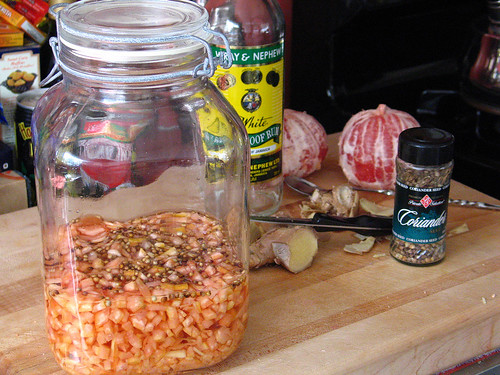The recipe was based on grapefruit peel and the bitter white pith, with only coriander as
a background flavor, steeped in Everclear. I tried to think of some other complementary flavors as I prepared the
ingredients, and consulted the handy-dandy flavor compatibility chart in Andrew Dornenburg and Karen Page's excellent book
Culinary Artistry.
That chart, dozens of pages long, is absolutely indispensible in my kitchen (and apparently in the kitchens of many
professional chefs as well), listing compatible flavor match combinations between myriad ingredients.
On my lunch hour one Friday I headed out to The Wine House, my favorite spirits-purchasing stop within a decently short drive from work. In the spirits section I ran into one of the staffers, who's seen me buying liquor there all the time, and he asked me if he could help me find something. "I'm looking for the dreaded Everclear," I said. He almost-successfully held back his expression of distaste (yeah bra, the guy you've seen in here buying 15-year-old George T. Stagg Bourbon, Amaro Nonino, Marolo Chamomile Grappa and both varieties of Chartreuse is going to go back to his dorm room and make Purple Jesuses, right). "We don't carry it," he replied, politely but curtly. A moment later I noticed a bottle of Wray and Nephew White Overproof Rum.
Hmm. Almost the same proof as Everclear (151, in California, as apparently 190 proof Everclear isn't legal here; according to this label scan W&NOP used to be a 151), yet with something that Everclear lacks ... flavor. In fact, my recollection of the grapefruit entry in the flavor compatibility chart listed rum as one of the flavors with which it's particularly compatible. Might be more of an interesting flavor base, mightn't it? Let's give it a whirl, I thought, and at $17 not too expensive of an experiment.
I wanted at least one more background flavor element, so in went about an inch of fresh ginger, peeled and julienned. My grapefruilts were large, and the amount of spirit called for in the original recipe didn't even cover all the ingredients, so I just added all the rest of the rum. Hell, if it turns out to be good I'll have more than enought to give some away.
Studying the flavor charts a bit more ... I decided to get a little wild and throw in a couple tablespoons of cashews too. It have a subtle but very interesting layer to the background flavor which will likely be undetectable once it's dashed into a drink, but gives it just another bit of complexity.

- One 750ml bottle Wray & Nephew Overproof White Rum (126 proof)
- 2 large grapefruits
- 1-1/2 heaping tablespoons coriander seed
- 1 piece fresh ginger, about 1 inch on each side
- 1/4 cup roasted unsalted cashews, roughly chopped
- 6 tablespoon sugar
- 3 tablespoons water
Peel the grapefruits and finely chop the whole peel, including (and especially) the white pith; that's where you're going to get most of your bitter component for these bitters. Peel, thinly slice and then julienne the ginger, and roughly chop the cashews.
In a large jar with a rubber seal, add the grapeferuit peel, coriander seed, ginger and cashews and pour in the rum. Seal and keep for one week, gently agitating the mixture daily.
After a week of maceration, strain the mixture through a fine sieve and then again through a coffee filter. Finish the recipe by adding caramelized sugar syrup -- place the sugar in a small, heavy pan and heat over medium heat until the sugar melts and turns light-to-medium brown (be careful not to burn it). Remove from the heat and carefully add the water. Stir and/or swirl until all the sugar has dissolved. Add the syrup to the bitters and let stand until it's clear, then bottle for use. (I like to use empty Peychaud's bitters or Regans' orange bitters bottles.)
Oh, and if any of you are trying the Times' grapefruit bitters experiment, either following their recipe or futzing around with it like I am, please drop me an email and let me know!
creole and cajun recipe page | the gumbo pages
search this site
Chuck Taggart email chef (at) gumbopages (dot) com